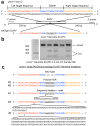In vivo genome editing using a high-efficiency TALEN system
- PMID: 23000899
- PMCID: PMC3491146
- DOI: 10.1038/nature11537
In vivo genome editing using a high-efficiency TALEN system
Abstract
The zebrafish (Danio rerio) is increasingly being used to study basic vertebrate biology and human disease with a rich array of in vivo genetic and molecular tools. However, the inability to readily modify the genome in a targeted fashion has been a bottleneck in the field. Here we show that improvements in artificial transcription activator-like effector nucleases (TALENs) provide a powerful new approach for targeted zebrafish genome editing and functional genomic applications. Using the GoldyTALEN modified scaffold and zebrafish delivery system, we show that this enhanced TALEN toolkit has a high efficiency in inducing locus-specific DNA breaks in somatic and germline tissues. At some loci, this efficacy approaches 100%, including biallelic conversion in somatic tissues that mimics phenotypes seen using morpholino-based targeted gene knockdowns. With this updated TALEN system, we successfully used single-stranded DNA oligonucleotides to precisely modify sequences at predefined locations in the zebrafish genome through homology-directed repair, including the introduction of a custom-designed EcoRV site and a modified loxP (mloxP) sequence into somatic tissue in vivo. We further show successful germline transmission of both EcoRV and mloxP engineered chromosomes. This combined approach offers the potential to model genetic variation as well as to generate targeted conditional alleles.
Conflict of interest statement
SCF, JJE, KJC and DFV hold shares in Recombinetics, Inc., a company that utilizes TALENs for genome modification in large animals. DFV is a listed inventor on a patent application titled “TAL effector-mediated DNA modification” that is co-owned by Iowa State Univ. and the Univ. of Minnesota, and has been licensed to Cellectis, a European biotechnology company.
Figures





Similar articles
-
Simple methods for generating and detecting locus-specific mutations induced with TALENs in the zebrafish genome.PLoS Genet. 2012;8(8):e1002861. doi: 10.1371/journal.pgen.1002861. Epub 2012 Aug 16. PLoS Genet. 2012. PMID: 22916025 Free PMC article.
-
High efficiency In Vivo genome engineering with a simplified 15-RVD GoldyTALEN design.PLoS One. 2013 May 29;8(5):e65259. doi: 10.1371/journal.pone.0065259. Print 2013. PLoS One. 2013. PMID: 23734242 Free PMC article.
-
A TALE of two nucleases: gene targeting for the masses?Zebrafish. 2011 Sep;8(3):147-9. doi: 10.1089/zeb.2011.9993. Zebrafish. 2011. PMID: 21929364 Free PMC article.
-
Genome editing using artificial site-specific nucleases in zebrafish.Dev Growth Differ. 2014 Jan;56(1):26-33. doi: 10.1111/dgd.12094. Epub 2013 Oct 14. Dev Growth Differ. 2014. PMID: 24117409 Review.
-
New and TALENted genome engineering toolbox.Circ Res. 2013 Aug 16;113(5):571-87. doi: 10.1161/CIRCRESAHA.113.301765. Circ Res. 2013. PMID: 23948583 Free PMC article. Review.
Cited by
-
Zebrafish as an animal model for biomedical research.Exp Mol Med. 2021 Mar;53(3):310-317. doi: 10.1038/s12276-021-00571-5. Epub 2021 Mar 1. Exp Mol Med. 2021. PMID: 33649498 Free PMC article. Review.
-
An optimized TALEN application for mutagenesis and screening in Drosophila melanogaster.Cell Logist. 2015 Feb 27;5(1):e1023423. doi: 10.1080/21592799.2015.1023423. eCollection 2015 Jan-Mar. Cell Logist. 2015. PMID: 26196022 Free PMC article.
-
The CRISPR system--keeping zebrafish gene targeting fresh.Zebrafish. 2013 Mar;10(1):116-8. doi: 10.1089/zeb.2013.9999. Epub 2013 Mar 28. Zebrafish. 2013. PMID: 23536990 Free PMC article. Review.
-
Mojo Hand, a TALEN design tool for genome editing applications.BMC Bioinformatics. 2013 Jan 16;14:1. doi: 10.1186/1471-2105-14-1. BMC Bioinformatics. 2013. PMID: 23323762 Free PMC article.
-
TALEN-mediated precise genome modification by homologous recombination in zebrafish.Nat Methods. 2013 Apr;10(4):329-31. doi: 10.1038/nmeth.2374. Epub 2013 Feb 24. Nat Methods. 2013. PMID: 23435258
References
-
- Huang P, et al. Heritable gene targeting in zebrafish using customized TALENs. Nat Biotechnol. 2011;29:699–700. - PubMed
Publication types
MeSH terms
Substances
Grants and funding
- GM088424/GM/NIGMS NIH HHS/United States
- GM63904/GM/NIGMS NIH HHS/United States
- R41HL108440/HL/NHLBI NIH HHS/United States
- P30DK084567/DK/NIDDK NIH HHS/United States
- R01 GM063904/GM/NIGMS NIH HHS/United States
- R56 GM063904/GM/NIGMS NIH HHS/United States
- R41 HL108440/HL/NHLBI NIH HHS/United States
- R21 DA032194/DA/NIDA NIH HHS/United States
- R01 GM088424/GM/NIGMS NIH HHS/United States
- F30 DK083219/DK/NIDDK NIH HHS/United States
- DK083219/DK/NIDDK NIH HHS/United States
- P30 DK084567/DK/NIDDK NIH HHS/United States
- DA032194/DA/NIDA NIH HHS/United States
LinkOut - more resources
Full Text Sources
Other Literature Sources
Molecular Biology Databases
Research Materials

